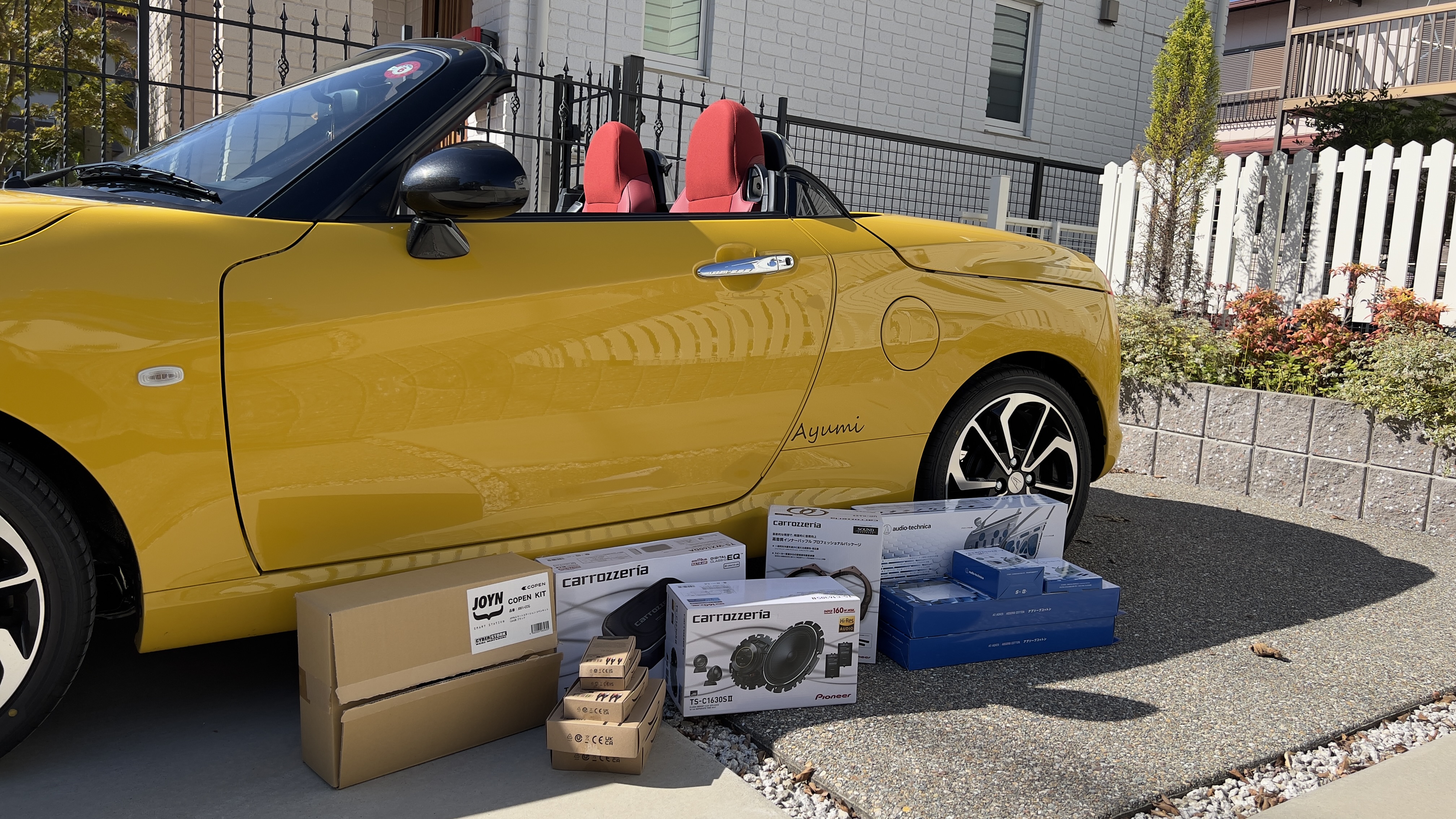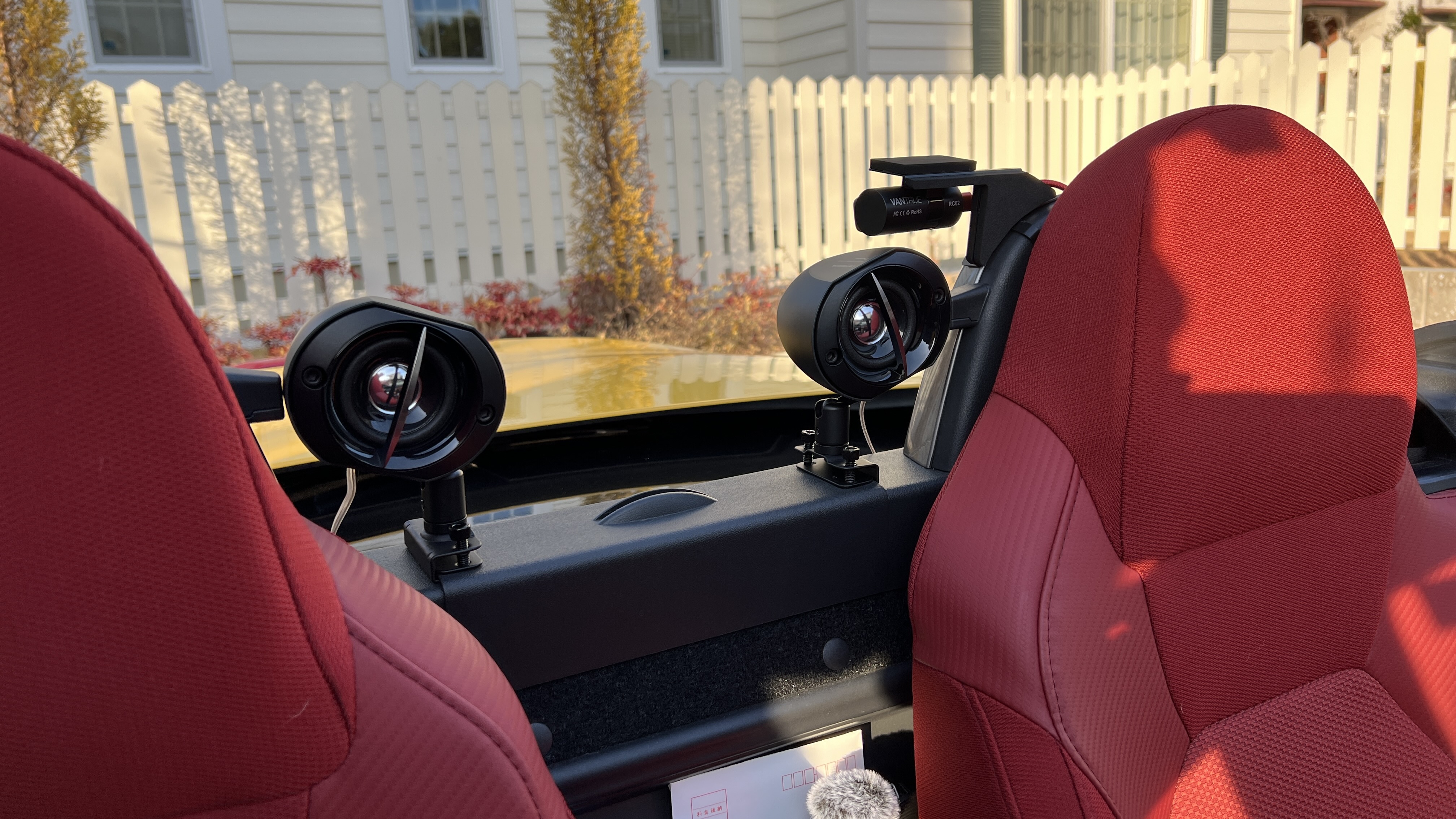Car audio systems that come pre-installed from the factory are rarely anything to write home about. The stereo often has a UI that is confusing, the speakers are often entry level, and the road noise washes out most of the fine nuance in the music once the vehicle moves faster than 40km/h. Because of this, I opted to not have any audio system installed in my car when it was delivered as my plan was to install very specific components to achieve the sound that I was after.
In October, less than a week after taking delivery of the yellow Copen, I got to work installing everything my initial research said was needed:
- a Joyn bluetooth stereo kit
- a Pioneer TS-C1630SII speaker kit, consisting of two woofers and two tweeters
- a Pioneer TS-WX140DA powered subwoofer
- and enough sound damping material to silence a toddler

The installation itself took a little over two hours and has worked pretty well since it was first powered on. However, when driving at highway speeds, music still tended to wash out. Podcasts were even harder to enjoy if one of the participants mumbled or had a thick accent. Suffice it to say, the initial work was an incomplete solution. Something else was needed to improve the audio quality.
Over the next few months I toyed around with different methods to improve the sound quality within the car. Additional padding was installed. Vibrations were chased down and eliminated. The trunk panels were bulked up with damping sheets. At one point some thick blankets were kept behind the seats to help muffle any sound that would come from that direction1. Some of the work resulted in improvements. Some of it did not. What I really wanted to do was find a way to build an active noise-cancelling system for inside the car. Unfortunately, this proved to be cost prohibitive2.
Last week I decided to approach the problem from a different angle.
The tweeters are located in the pillars that hold the windshield. The woofers are located in the door. The subwoofer is behind the passenger seat. This means that the main sound is coming from the front of the car while the lower-frequency elements are coming from behind. In some of the nicer cars I've been fortunate enough to ride in, the key to "luxury" is having a surround sound system badged with a Dolby logo, a Bose logo, or both. Given there is nothing inherently wrong with the Pioneer speakers, and the Joyn stereo is really the perfect accessory for the car, it made sense to look into transforming the five-speaker system into a seven-speaker solution.
One of the many challenges of installing parts in a two-seater convertible car is space; there is simply not very much of it for third-party additions. I've seen some people on X add speakers behind the seats in order to improve sound, but this would not really solve the problem that I had with sound clarity. I've even seen a creative person replace the rear window platform with a custom-speaker base. Both of these solutions made use of standard car woofers and could be done without spending too much money. However, I wanted something that would offer improved clarity while also being useful when the top is down. What I needed was a pair of unobstructed satellite speakers.
With a plan in mind, I started looking into which models might work for my car. Again, because the Copen is a rather compact convertible, mounting options are incredibly limited. Had I bought a car with a fixed roof, there would be dozens of potential solutions. I needed something compact that would also match the stylings of the car. Fortunately, Pioneer has the perfect solution: the TS-STX510-B satellite speaker kit.
A quick search online showed that Amazon had these on sale for 29% off list price. A few clicks later and a pair was scheduled for next day delivery.
The original plan was to find a way to mount these speakers to the seatbelt guide. This idea was scrapped when the sleek items arrived, though, as they were simply too heavy and awkward to place there. I would need something a little more sturdy … like the space between the roll bars.
In most convertibles there is a wind deflector between the roll bars. This is said to accomplish two goals:
- Air from inside the car – such as the A/C – would hit the deflector and stay in the vehicle
- Air from outside the car would not be able to enter over the trunk as a result of wind channel patterns
I do not know if either of these are actually accomplished by the 5cm tall piece of clear plastic that sits between the driver and passenger roll bars, but it almost doesn't matter. The speakers have to go somewhere, and between the seats strikes me as the most logical.
So that's where they went.

And they're perfect.
This evening I went for a little trip around Aichi prefecture to test the new sound setup and came away incredibly impressed. Not only can I hear many more details in the music that I listen to, but the road noise has also diminished quite a bit. This is most likely due to the proximity of a bare speaker to my ears, but it's a nice little bonus. Sirens from ambulances and police can still be heard, as can the horns from impatient or frustrated drivers, but the endless droning of tires on pavement has been masked reasonably well. Hopefully they're just as effective when listening to spoken-word podcasts.
Later this year, after the temperature warms up a bit, I hope to install a bit more sound damping in the car to reduce a bit more noise3, but I really feel that the audio setup is just about perfect as it is.
These would also come in handy in the event the puppy dog and I needed to keep warm for some reason … like waiting to watch the first sunrise of the year from the windy shores of Shizuoka Prefecture.
I was not willing to spend over $800 on more electronics that would muffle exterior sounds with the help of microphones that required holes to be drilled through the body of the car in various places. I know "it's just a car", but I'm not yet ready to start poking permanent holes into the body.
I am surprised by how much styrofoam is in the car. Sure, it's light and doesn't mind getting wet, but it's a horrible material for sound absorption or dissipation.